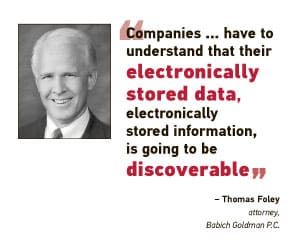Don’t get burned
Having strategies to preserve electronic documents could save your company time, money and credibility

Businesses need to have a strategy for archiving and organizing electronic documents – such as emails – so they can be easily retrieved in the event of litigation.
Many don’t – and are setting themselves up to get burned in court.

“You run into a problem because you have to produce all this stuff and you have to do it in a timely manner, and if you are unable to do that – or if your system is set up in such a way that it has automatically deleted things that might be relevant – what has happened in the courts is they have looked on that as something that’s not very good,” Ogden said in an interview with the Business Record.
He cited a recent court case where the judge said, “The sideshow has become the circus” when it comes to businesses trying to provide the relevant emails and electronic documents such as cellphone records or personal messages.
“And in essence, that’s what you’re trying to prevent as a business person,” Ogden said. “You are trying to prevent the litigation from being decided on something other than the merits of the case.”
Not to be overlooked is the possibility for a businesses to face court-imposed sanctions for not being able to produce relevant information, as well as the time and money that can go into retrieving electronic documents that haven’t been properly saved.
And if your business can’t produce an electronic document that the court says it should be able to provide, it will likely hurt your business’s case.

“In any litigation, employers, companies … have to understand that their electronically stored data, electronically stored information, is going to be discoverable (or subpoenaed as potential evidence),” Foley said. “And if they don’t make efforts to preserve it, it’s going to come back to haunt them.”
The Business Record spoke with legal experts to find out what businesses should be contemplating regarding e-discovery and put together a list of best practices when it comes to your business developing an e-discovery policy.
How not to get burned

“I think too many organizations still view e-discovery as an event-driven project. What it really should be seen as is a business process,” said Charles Volkert, executive director of California-based Robert Half Legal and co-managing director of Robert Half Legal eDiscovery Services. Making e-discovery a process requires having the right procedures in place before a business gets to a point where it can expect to go to court. Because once the business finds out it can expect to be sued, it’s going to take a much heavier effort to retrieve and sort through documents if there was no policy in place prior to litigation happening. “(Businesses) really need to be thinking to themselves, ‘If we put our methodology in place now, even though that’s going to be costly in many circumstances, it’s certainly far less expensive than the fire drill towards the middle or end of a litigation,’” Volkert said.
Notice trigger events:
Having a document retention policy before going to court is important, but knowing when your business needs to put the policy on hold and start saving any and all relevant documents is critical. Your business’s policy could be to delete emails after 60 days, for example. But after what Ogden refers to as a “trigger event” occurs, the business must start saving emails regardless of the policy. A trigger event could be an employee termination or anything else that leads the company to reasonably believe it could get sued. Often signaling a trigger event will be a litigation hold letter from an opposing lawyer notifying the company that court activity could be coming. At that point, it’s time to save emails and other electronic communication, regardless of the policy.
Realize it’s not just emails:
The term e-documents refers to more than just emails. It can refer to text messages, blog entries or social media content. Businesses could be asked to provide all electronic communications between certain people. Privacy issues are still undetermined in some cases, said Volkert, but lawyers at Babich Goldman warn that any expectation of privacy in electronic documents, including emails from a personal account or text messages on personal cellphones, could be misplaced. “Particularly if you are doing it to try to avoid discovery obligations, I don’t think that’s going to get you very far,” Foley said.
Make sure you can retrieve e-docs:
Businesses that can’t retrieve relevant information that should be retrieved could face court-imposed sanctions. Beyond that, it could hurt the business in court, Ogden said. Judges will assume that missing evidence would have been detrimental to the business’s case. Put another way, said Foley, “If (e-documents) are gone, and we don’t know what they are, then the jury and we are left to surmise. And if it’s information they should have retained, then (jurors) will have an instruction that won’t be too favorable to (the company).”
4 quick tips … for developing an electronic document retention strategy
1. Decide what kind of e-documents the company needs to keep and what it can get rid of. For example, emails that could be important to future business functions should be kept, but things such as calendar invitations could muck up the process later when a lawyer is trying to find emails that are relevant to a case.
2. Have good organizational charts; know who would have what information in the business. Also, if multiple people are in charge of document retention, make sure they are all doing it the same way. Identify “priority employees” – people higher on the organizational chart, who might be more likely to be asked to provide e-documents someday and therefore might need different retention rules.
3. Develop your policy independent of a litigation event, and don’t change the policy during a litigation event to try to get rid of emails that could be relevant to the case.
4. When developing a strategy, consult lawyers and data management experts in advance of the possibility of litigation. Practice and do test runs of the procedures that would take place during litigation to be prepared.











